so who made
Wiley’s
acme products ?
Bob McCown said:
Wasn’t there somebody making laser cut dynamite boxes?
House of Balsa though I don’t know if they are still offering them
https://houseofbalsa.com/train/dynamite-boxes-10-per-kit-1:24-scale
House of Balsa was about 15 miles from us. I think they closed a couple years back.
Doug Arnold said:
House of Balsa was about 15 miles from us. I think they closed a couple years back.
Website is still active with current update listed as 2018.
Modeling Explosive Transport on the Layout
Move it or lose it:
Most freight stations had neither the secure facilities for storing shipments of explosives or the desire to be responsible for them after arrival. Once the material was unloaded on the freight dock the buyer was expected to be there to take ownership.
Prior to the mid 1880’s a buyer could pick up his items in any form of conveyance and move them to his own property for storage with little or no legal requirements. For that matter the shipper (usually the manufacturer) could consign the shipment with no formal oversight. If a railroad or teamster did not want to transport explosives such as pure nitro-glycerin then unscrupulous dealers packed it in boxes labeled “bibles” or “syrup”. Naturally freight workers would be unaware of the dangers and would treat the containers with disregard. This resulted in more than a few accidents of significant property damage and loss of life.
To model these free wheeling times draft animals and or wagons would be appropriate with wooden barrels and boxes comically labeled “TNT” or “Blasting Powder”. Storage could be anything from a tarp to a cave. Now this is not to say that there were no regulations at all, just not any standardized ones and none that expressly outlined grounds for prosecution. Most regulation that existed were corporate policy or local city ordinances.

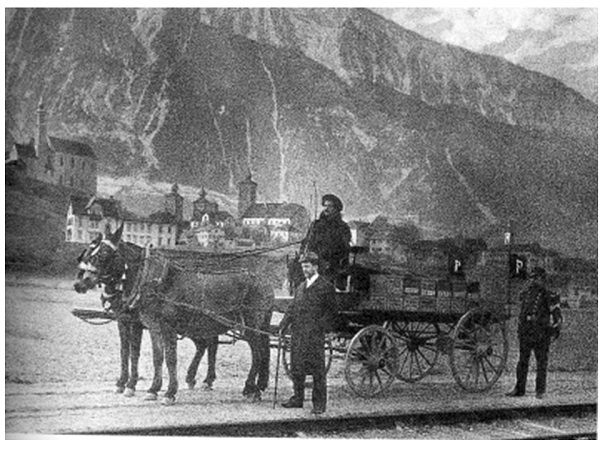

A new Sheriff comes to town:
Public outrage and President Roosevelt’s zeal for anti-trust crusades changed this with the passage of the Interstate Commerce Act of 1887. This made the railroads the first industry to be federally regulated. It dealt mostly with operations and safety devices but buried in the act was the ground work for regulating the transport of explosives. A series of legislative acts over the next two decades shaped what became the specifics of the regulation. Here are the highlights…
- Interstate Commerce Act of 1887 - established the Interstate Commerce Commission and sets it’s areas of responsibility. A this point it was mostly a toothless tiger with high ideals.
- Hepburn Act of 1906 - extended the ICC’s authority beyond the railroads to all common carriers including trucking companies, bus lines, freight forwarders, water carriers, oil pipelines, transportation brokers, and express agencies.
- Transportation of Explosives Act of 1909 - required containers to be marked with description of contents and listed violations as federal crimes
- The Transportation of Explosives Act of 1921 - directed the Interstate Commerce Commission to regulate shipments in interstate and foreign commerce
- Institute of Makers of Explosives 1935 - Publish the first edition of “Safety in the Handling and Use of Explosives”. Produced by the major manufacturers of explosives it was not legislative. Together with DuPont’s manual “Farming With Dynamite” the safety practices listed in the publications later became the basis for many federal and state laws governing the handling and use of explosives. A rare instance where the industry took the opportunity to get in front of the regulatory body over-seeing them.
- Code of Federal Regulations Title 49 1938 - Publication of Title 49 was originally titled Transportation and Railroads. It was renamed in 1949 to Transportation. It was the first Federal regulation to codify the IME and ICC rules for packing, transporting and using explosives. Most importantly it gave the ICC the ability to use other Federal agencies by direction or delegation enforcement authority over its regulation.
- WW II - multiple amendments and revisions during and after the war years gave the ICC the ability to consolidate railroads and settle labor disputes in interstate commerce.
- Department of Transportation Act 1966 - created the DOT and transferred the ICCs safety functions
- Staggers Rail Act and Motor Carriers Act of 1980 - ended the ICC’s powers over rates and routes in railroads and trucking
- The ICC was disbanded in 1995 with the creation of the National Surface Transportation Board
With the guidance in 49 CFR (based on the IME Handbook) we have the standard for explosive packaging as of 1938, most of which had been in use since the early 1900s but now had some standard requirements. It also stated the grounds for criminal prosecution for intentional deceptive labeling.
- The words “High Explosives” and “Dangerous” had to appear on two sides (or one side and one end) and the top
- The ICC packing standard for the product had to appear on two sides (or one side and one end) and the top
- All of the following had to appear on one end:
- Product name
- Manufacturer
- Type of explosive (proper name)
- Explosive description
- Number of items inside over-pack
- Weight of explosives
If you want to create your own local explosive company in the pre-war years use the pic below as a guide for your labeling.
For the packaging standard you will have to look up the correct abbreviation in 49 CFR. ICC -14 means a wooden box with dovetail corners. There are other codes for barrels, metal drums, fiberboard boxes and carboys, all of which could be used for transporting explosives.

Now for the trucks. The IME handbook 1938 version lists the criteria for motor vehicles transporting explosives over public roads. Most of it is common sense items. Inspect the vehicle for damage or non-working equipment, brakes, lights, leaking fuel etc. It also covered what types of vehicles designs could be used. For example, enclosed box, covered cargo area, side walls and tie downs. The minimum requirements were a flatbed truck with rails tall enough to prevent the load from falling out and an oiled tarp to cover the explosive boxes (to keep them dry). Two fire extinguishers were required.
The vehicle was to be marked as follows:
Vehicles should be labeled on both sides and the rear with the word “Explosives Dangerous” in letters at lest 3” high or display a red flag 24” square with the word “Danger” in white letters 6” high.
Pre-war vehicle markings;
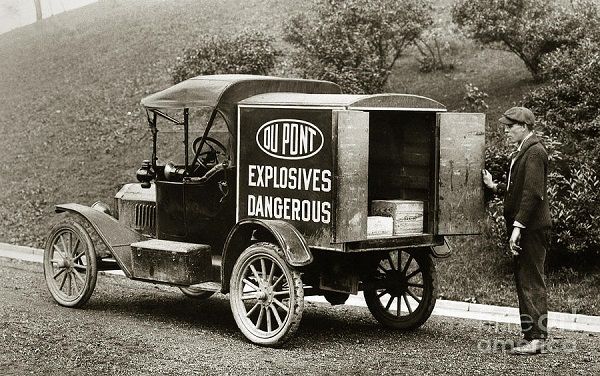


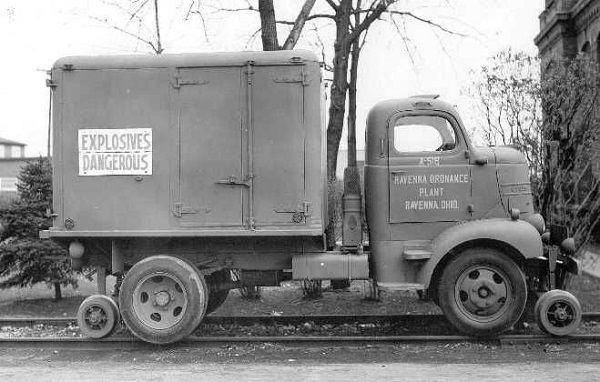
I believe the 1940 Dodge COE with the hi railer system is a must for my rail truck project.
Post war vehicle markings


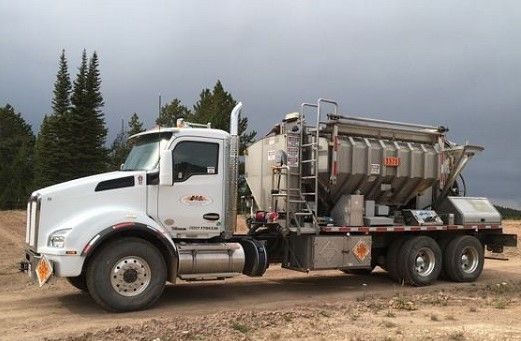
A little regulation is good… a lot is better
Along with the handling and packing standards another line of regulation was developing. This one was more concerned with storage. In 1909 a group of railroad and civic leaders began to question the proximity of manufacturing and storage facilities to railroads, highways and occupied buildings. Today we know it as “intraline distance” but that term would not come into use until after WWII. It means the distance at which a given amount and specific type of explosive would pose a hazard if accidentally detonated while in storage or transport (including manufacture). This was further broken down in to two types of hazards, blast over-pressure and missile debris. Over 200 accidents and incidents were studied. This resulted in the 1914 American Table of Distances (ATD) published by the Institute of Makers of Explosives (IME).
The Atlas Powder plant and its attendant rail lines.

Blast over-pressure is a measure of force on the human body above standard atmospheric pressure. It causes injury and death by bursting the cell walls.
Missile debris is anything thrown from the seat of the blast at ballistic speed sufficient to cause injury. This could pieces of casing, the transporting vehicle or the storage magazine.
The IME report became the basis for New Jersey state laws on explosive safety. These were then adopted by the US Army and finally by the Department of Defense for a multitude of military explosive handling regulations. In 1928 Congress incorporated the New Jersey laws into a revision of the Transportation of Explosives Act making them federal law and the national standard. They were incorporated into 49 CFR in 1938 which later expanded the idea of safe storage from package labeling to storage and transportation markings in 1949.
The storage compatibility groups were a series of letters covering all hazardous material. I am only going to cover the explosives portion. The basic idea here was that certain types of explosives should not be transported or stored together in the same vehicle or magazine. Ie. Detonators (initiators / blasting caps) should not be stored with bulk primary explosives such as dynamite or trinitrotoluene (TNT).
This version was used by the military ( and sometimes by civilians) for storage. In the event of a fire the paint might be burned off so the unique shape could still serve as a warning to let first responders know what kind of material has been stored in the facility.
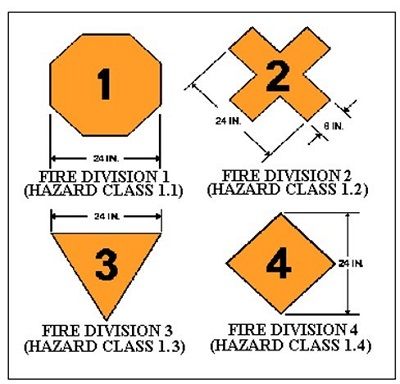
This style by military and commercial vehicles until December 1990.

In 1991 a revision to 27 CFR 55 (Commerce in Explosives) added the Hazard Class Division. This is a series of digital codes that tell what kind of danger a particular explosive poses. It also standardized the placarding system for all hazardous materials. Beginning in January of 1991 packaging, transport vehicles and storage all used the new DOT combined placards.
Current classification
Class name prior to Jan. 1, 1991
Division 1.1 … Class A explosives.
Division 1.2 … Class A or Class B explosives.
Division 1 3 … Class B explosive.
Division 1.4 … Class C explosives.
Division 1.5 … Blasting agents.
Division 1.6 … No applicable hazard clas


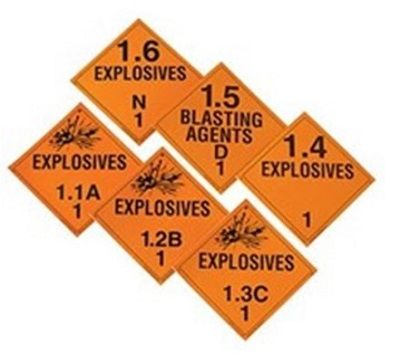
Next up, the design of storage facilities.
My son in law is the shooter for a tunneling company in Chicago, and was working in a historic area of town, they had to take extra care with suppression mats and the ammount of dynamite they could use to not disturb any of the buildings surrounding the shaft they were digging down to start the tunneling. I think he would be interested in this article! thanks Boomer
And anyone wonders why they call him “BOOMER”!
And here I thought it was because of his fondness for green chilies!
Modeling Explosive Storage Magazines on the Layout
Looking for a home
Storage facilities for dynamite and other commercial explosives was the last item to be regulated. In fact until 1935 the only real guidance on construction was the explosive manufacturers recommendations and the buyers personal experience. This was limited to “keep it secure” and “keep it dry”. This was soon supplemented by “keep it separated”.
This wooden storage bunker fit those early requirements.

More permanent facilities used stone, brick or block with wooden or metal roofing. It would have been very common to see something like these examples located on the periphery of the mine camp or company town with a temporary wooden structure in close proximity to the working face or cut. Bulk explosive amounts would be stored in these and enough for each days blasting brought up to the work site as needed.



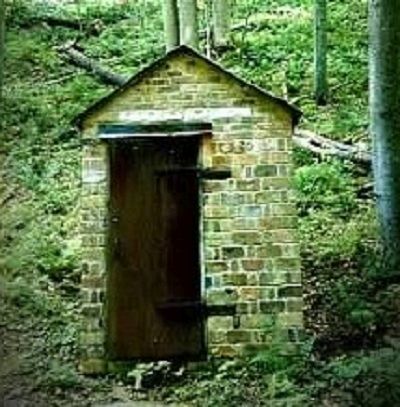
Placement of the magazines would be governed by the 1914 ATD but with the advent of the professional blaster and the IME new but unofficial design features became common. These were based on the realization that an accidental explosion was likely and should be planned for. By the 1920s many of these had become common practice:
- Facing of the door away from other magazines and the worksite
- Steel door for security
- Bunkering of the walls by palisade or partial burial
- A sound but expendable roof that would allow the blast to vent upwards
- Multiple bays or storage rooms to separate detonators from primary explosives
With the publication of the IME handbook in 1935 these practices were added:
- Ventilation to keep humidity and temperature low (but above freezing)
- Painting of the interior with aluminum paint to help keep the temperature low
- Dunnage to help prevent the accumulation of toxic fumes and to allow for inspection under a stack of material for leaks
- Lined with weak cement or sandbags to make the facility bullet resistant
During World War II the following requirements were added:
- Explosive proof lighting and electrical systems
- Grounding rods
In the mid 1990s criteria for venting over pressure was applied to the construction standards of portable steel magazines.
After the 9-11 attacks numerous security requirements were added.


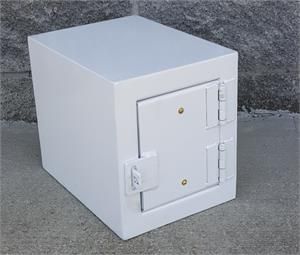
A modern large magazine with all the bells and whistles.

The care and feeding of explosives
There were a few handling practices that also became standard.
Dynamite being a gel (mixture) would allow the nitroglycerin to seep to the bottom of the sticks. To keep it in peak condition the sticks would be marked on the end and every few days turned 1/2 rotation so the gravity would pull the liquid in the other direction. If left unattended the nitro would leak out into a dark puddle or worse from explosive salt crystals called exudite. This was known as “sweating” or “exuding” and could be a very dangerous condition. Dedicated handlers kept the sticks in wooden racks like miniature wine cradles other just flipped the entire case hoping to use it u before it got to old.
Safety fuse contained black powder which in turn is hygroscopic meaning it would absorb moisture from the air. Since it had to burn at a stable rate it was imperative that it stay dry. just being in a dry bunker was not good enough. The product was supplied in a tin can with a key similar to Spam. Once open it would be transferred to a metal box with a close fitting lid. It is common practice to tie a knot in one end of a roll of fuse to indicate the “tail”. Lengths to be used would then be cut from the other end to help keep it fresh.
Temperature was a big issue. Explosives such as dynamite and thermite could detonate if they froze while safety fuse, blasting caps and ammonia based explosives can degrade and fail if overheated for extended periods.
Finally we are to the part where somebody gets to use the explosives.
West and slightly south of St. Louis, Missouri sits the Busch Wildlife Management Area. Yes, that Busch, like in the Beer Baron. But no, not that type of wildlife.
During WWII, it was known as Weldon Springs and was a big munitions and storage facility. During the 50’s and the 60’s, it had over 30 lakes and was a place where my Dad liked to fish on Sundays. The place was full of old bunkers, buried in the ground, except for the concrete door ends which was exposed and some were even open. Big, empty, concrete structures shaped like quounset hut style structures. And a source of great exploration, when I got tired of fishing, which was often. Can’t tell you if the doors didn’t face each other, but I guess it could be that way.
In the 1980’s they found the ground water contaminated with all kinds of radiation and I don’t think you can fish there any more. Never noticed the fish glowing.
Dynamite was a quick way of removing stumps after felling a tree. My dad tells of playing in his yard as a kid while skme neighbor was claring a few stumps when one unceremoniously landed aa few feet from him…that was the end of play for that day!
Back in the late 80’s here in Phoenix area , a pickup, while transporting dynamite to a blasting site north of town blew up and the engine landed on a car about 200 ft away . I think the guy tossed a cigarette out the window and it landed in the bed and eventually set it all off.I dont think they were following any of the rules at the time.
Modeling Explosive Handlers on the Layout
Whose who in the bang gang
Powder Monkey - the oldest term applied to anyone working with explosives. The name originated in the 17th century onboard naval vessels. It denoted a young boy whose job was to carry black powder during battle from the ships magazine to the gun deck. The name carried over to early engineering blasting with the use of black powder. It became the common term for workers on hard-rock demolition projects of the 1930s such as Mount Rushmore and the Hoover dam. It fell into disuse after WWII. On the Cibola Lumber and Mining Company the name of the corporate AA Baseball team is the Powder Monkeys. The miners chose the name as they lived in town and formed most of the team. The lumberjacks spent weeks, sometimes months out at the lumber camps and were seldom available for games.
Shooter - the second oldest term dates back to the late 1800s. It originated in the oil fields of Pennsylvania. The crude oil discovered in the area has a large amounts of wax, tar and sediment which would cause the bore holes to plug up. To clear the holes and restore production an explosive charge called a torpedo (steel tube filled with nitroglycerin and later dynamite) would be lowered into the hole and detonated. This was called “Shooting a well” subsequently the term “shooter” was applied to the men who performed this very dangerous job. The name was later applied to anyone doing any explosive work in the oil industry including fracking and site preparation. Today a shooter is someone who does engineering demolition especially hard-rock for construction.
Blaster - this term came into common use in the twenties. Its exact origins are considerably more vague but the term is used in Dupont’s Farming with Dynamite handbook. The term “blasting tree stumps” or “blasting a ditch” are both used. In logging companies a “Blaster” was someone who went out and threw sticks of dynamite into the river to break up log jams. Since WWII the term has migrated into the vernacular of quarry work. With the advent of non-electric firing line the term blaster is becoming the most common term for explosives workers.
Explosives Expert - no such thing exists but it is occasionally referenced in military jargon starting with the Battle of Britain in WWII. This is someone who deals with ordnance munitions of all kinds but not engineering demolition (although they use the same basic materials). The official definition according to the US Joint Service EOD program is: “Someone who knows the exact amount of C-4 to pack up a bulls ass to knock it’s horns off without making it’s eyes water”. end quote.
A “Powder Monkey” onboard a Union ship during the Civil war.

Chinese laborers chipping a rock face on the Central Pacific. The same technique was used to prepare bore holes for early black powder charges.

Hard- rock miner circa 1900. Notice that the explosives boxes do not have the labeling that showed up in the 1920s-30s

Shooters preparing their torpedoes sometime in the 1920s. They are driving a 1909-10 Ford Model-t runabout converted to a flatbed. I am guessing Texas or California based on the number and close proximity of steel derricks in the back ground.

Blaster clearing stumps in the 1920s-30s.

Powder Monkeys working on the Hoover Dam. There is a monument to the men who worked the rope seats at the visitors center north of the dam.

Blasters with the Civilian Conservation Corps pack charges for site prep on the Salmon River Road.

Molybdenum Mining in the early 1950s

Paul “Red” Adair packs a drum with dynamite for suppression of a oil well fire in the middle east. This real life story was the subject of the movie “The Hellfighters”

Shooters loading bore holes for tunnel work. The yellow stuff is non-electric firing line.

Modeling notes rubble
A few miscellaneous notes for modeling the use of explosives.
Publications on explosive safety pre-WWII.


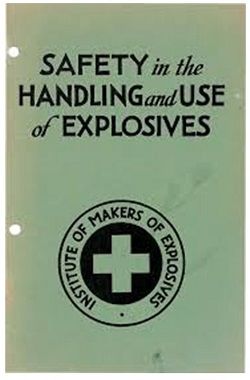
Publications on explosive safety post WWII

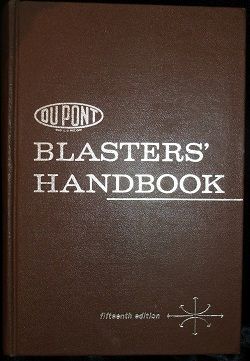
1920s poster

Blasting machines
Invented by Julius Smith in 1886 this plunger style capacitance blasting machine could detonate 50 blasting caps in series. It was in use until the late 1960s. The handle was first raised to get it out of the way then the wires leading to the charge would be attached to the terminals using the wing nuts. When ready the plunger would be shoved down hard and fast. This would spin a dynamo creating voltage. When the plunger reached the bottom it closed an internal switch completing the electric circuit and detonating the blasting caps. It only took once for a blaster to learn to keep his hands open and on top of the handle… otherwise you got your fingers smashed.
Next to it is a battery powered blasting machine from the 1920s. This technology would not be brought to maturity though until the 1990s.


Capacitance blasting machines got smaller and easier to use over the years. The t-handles showed up during WWII and the grip style in the 1970s. The battery powered detonators became common in the 1990s although some versions were available as early as the 1960s.


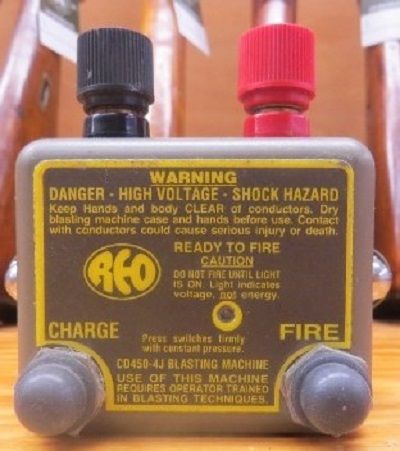

Of course you needed a roll of wire and blasting caps. The old school style spool is on the left dating from the 1930s. The new one in the middle and both electric and non-eletric blasting caps on the end.



The latest innovation is non-electric firing line called “Nonel”. It is a very small diameter plastic tube containing HMX dust. It is very safe, cheap and reliable. The special igniter sends a small charge down the tube to the blasting cap. The system is well suited for modern blasting and includes a wide selection of boosters, splitters and delays to allow for complex multi charge shots. The blasting machine below can detonate both electric caps and Nonel. In both instances it uses a rechargeable battery.

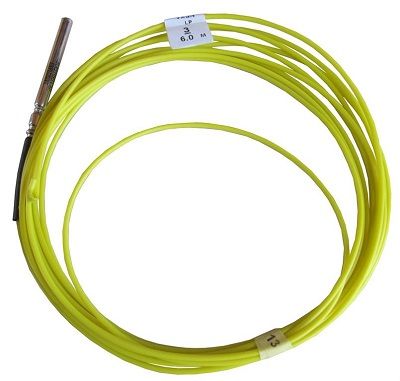
This is a university sponsored explosive safety training vehicle. I could see something like this, perhaps sponsored by DuPont, at a farm COOP giving a lecture or demonstration.

Another explosive safety training effort from the 1930s. This one was set up near the Hoover dam site.

Here is an explosive storage magazine mounted on an old caboose frame.

And of course when you have to take the explosives into the mine you need a designated ore car. The IME handbook describes one of these as having doors on top to cover the primary charges and separate small compartment accessed from the front for detonators.

That is all I got. Thanks for giving it a read.
My parents were rockhounds and so I have collected rock since I was a youngster.
A close friend collected rock since the 30s and he was always fun on a collecting trip. He knew how to use dynamite.
If you had rock that need ed nudged he was always happy to help.
Most people have only seen big blasts in movies not realizing that if you know what you are doing you can always just loosen up what you want without a big boom!
Eric Schade said:
Dynamite was a quick way of removing stumps after felling a tree. My dad tells of playing in his yard as a kid while skme neighbor was claring a few stumps when one unceremoniously landed aa few feet from him…that was the end of play for that day!
Eric, I had a similar experience. It was a very surreal experience watching a tree stump come sailing up over this guy’s house and landing in the middle of his driveway.
Explosives Expert - no such thing exists but it is occasionally referenced in military jargon starting with the Battle of Britain in WWII. This is someone who deals with ordnance munitions of all kinds but not engineering demolition (although they use the same basic materials). The official definition according to the US Joint Service EOD program is: “Someone who knows the exact amount of C-4 to pack up a bulls ass to knock it’s horns off without making it’s eyes water”. end quote.
LMAO. Sounds like a military guy alright.
Thanks Boomer! Great stuff.

I want one !
" Rooster " said:
I want one !
Me too! Unfortunately, a quick Google search showed that even a replica sells for $200 or more. 
Ray, so scratch-build one. Its a wooden box, with some detail bits.
Link to how to make the graphics for the dynamite crates and other stuff.
sorry the link is dead.